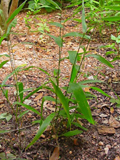Native Plants

Q. Who is Mr. Smarty Plants?
A: There are those who suspect Wildflower Center volunteers are the culpable and capable culprits. Yet, others think staff members play some, albeit small, role. You can torture us with your plant questions, but we will never reveal the Green Guru's secret identity.
Did you know you can access the Native Plant Information Network with your web-enabled smartphone?
Ask Mr. Smarty Plants is a free service provided by the staff and volunteers at the Lady Bird Johnson Wildflower Center.

rate this answer
Thursday - April 29, 2010
From: Whitehouse Station, NJ
Region: Northeast
Topic: Problem Plants, Grasses or Grass-like
Title: Aggressive native Inland Sea Oats in Whitehouse Station NJ
Answered by: Barbara Medford
QUESTION:
Can you direct me to a source of help managing a very aggressive grass, Chasmanthium latifolia, Woodland Oats or Indian Sea Oats. It is behaving like a very noxious plant and I am concerned as I am having trouble controlling it.ANSWER:
We are surprised to find someone wanting to get rid of Chasmanthium latifolium (Inland sea oats). In Texas, many gardeners love it, because it is one of the few grasses that really do well in shade, it looks good most seasons, and will virtually make a hedge with it's graceful stems and "oats" hanging over. However, everyone has their preferences and we will see what we can do to help you.
From Wayside Garden, we found this article Three Seasons of Showy Color for the Shade; they don't consider it invasive but several of the responders in Dave's Garden do. This Floridata site, Chasmanthium latifolium, conceded that it could be invasive if you had it in moist soil and sun, so that's at least a clue.
We found no one saying "This is a pest, and this is how to get rid of it," so we will have to do it. First, don't let it seed; in fact, keep it cut down very low. This can eventually starve it out, but it's a little slow. The roots are apparently fairly easy to transplant, so we're assuming they are also easy to dig out. If you have it growing in a garden situation, that is going to make it harder, because you may have to keep the soil moist for the garden plants, and don't want to disturb the other plant roots to dig up the grass roots. It can spread both by seeds and roots, you'll have to address it on both fronts. Since it is a grass, a member of the Poaceae family, you can purchase a weed killer for monocots, only; that is, grasses. When a plant has a good root system like this one does, it's difficult to get the herbicide to the roots. You might try cutting it down as much as you can, which eliminates seed, and then painting the stalks left in the ground with the herbicide and a small disposable paint brush. Be careful, though, your lawn is probably a grass, too, so we don't recommend spraying. Dig out as many of the roots as you can, and dispose of them where they won't regrow. You'll have to keep watching for it and grubbing it out as it comes up in the Spring.
From our Native Plant Image Gallery:
More Problem Plants Questions
Young huisache trees dying
October 02, 2015 - We have had several young huisache trees suddenly die. These trees are only three or four years old and were apparently healthy when they just died. They are growing by the curb on a city street and w...
view the full question and answer
Want to identify thorny vines growing in Charlotte Hall, MD
April 25, 2013 - I have vines with thorns growing in my wood, vining around the trees and killing them. It grows and vines go up trees of any height all the way to the top. It has green pointy leaves. If it doesn't...
view the full question and answer
Elimination of non-native English ivy in Maryland
March 11, 2009 - I have Old English Ivy sprouting up throughout my side yard. What can I do to get rid of it? Would putting lime down help or Crabgrass control? What would you suggest and the easier the better as I...
view the full question and answer
Identification of a plant with winged stems in Texas
July 08, 2013 - Dear Mr. Smarty Pants,
We live in Denton Texas & our backyard is being taken over by a very woody type weed or bush. The most distinguishing characteristic is that long thin vertical ridges or fins...
view the full question and answer
Identity of stinging weed in Pearl, Mississippi
March 20, 2016 - I live in Pearl, MS. Yesterday I pulled a weed that right away started stinging my hand and in a few hours turned into stinging numbness. The weed has dark green heart shaped leaves with purple veins ...
view the full question and answer
| Support the Wildflower Center by Donating Online or Becoming a Member today. |


